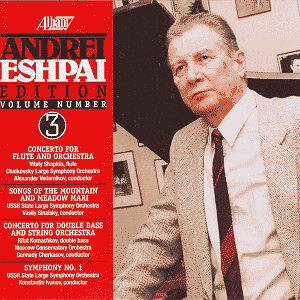Albany has a special relationship with Eshpai.
In February 1992 he attended a concert of the Albany Symphony
Orchestra when they performed his Concerto For Orchestra.
The master tapes on which this series of recordings is based came
directly from the Eshpai family.
The 1994 Flute Concerto is here
given in a live recording of its world premiere. It includes some
of the haunting Mari folk tunes used in The Circle some
20 years previously. Another element is birdsong caught in the
nets of a brusque and dissonant fantasy. The flute though is not
called on do unnatural things although its demands on technique
seem to be intimidating - both for soloist and orchestra (the
very same that recorded the complete Ivan the Terrible music
for Nimbus). Shapkin sloughs off the challenges with utmost confidence.
The work arrives at heart’s message at 0909 after which the solo
part and the orchestra in chase careen, chicane and cartwheel
their way through the piece. The concerto ends with the delightful
‘breathing’ of the flute.
As you may gather from the title Songs
of the Mountain and Meadow Mari (1983) is a lighter piece
than the concerto though still having a strong role for the flute.
Here that role is much more calming than in the Concerto. The
music touches on the highland romance of the misty mountains of
the Tatra, of Szymanowski's Harnasie and of Delius’s high hills.
At times the effect is Gaelic (3.47). At 7.40 it briefly becomes
more dissonant following Espai’s tendency for stylistic impacts.
After this episode the flute returns in peaceful song - a priest’s
invocation to peace. This a brief and brilliant piece without
the hyper-Hollywood effects of the Concerto for Orchestra.
The Double Bass first appeared in Eshpai’s scores
as one of the solo characters in the 1966 Concerto for Orchestra
(see Vol. 2). In 1995 he completed a Double Bass Concerto.
Unsurprisingly the dissonance of the Flute Concerto of 1992 is
also in evidence here. The work gloomily tracks the territory
between Bach and Shostakovich. Rifat Komachkov is impressive fully
exploiting the deeply resinous woody sound of the double bass.
The work ends with strings aglow and the solo singing out in full
eloquence. The effect is rather is rather like a supercharged
Tallis Fantasia.
Eshpai’s First Symphony (1959) is unusually
in bipartirte form: a lento maestoso then an allegro
vivace festivo. The recording is in slightly crumbly sound
but good enough. The first movement takes the form of a requiem
- an expressive meditation, sombre and rising to a gaunt hymn.
It is touched with the pomp of the grave and does not escape bombast
(6.20). This sober movement occasionally reminded me of Miaskovsky.
The second starts with folksy dance material and the textures
are as usual with Eshpai extremely inventive - try the chiming
episode at 1.40. It rises to a rhapsodic and high rolling massive
rush of sound. This is a very colourful score touched with the
influence of Shostakovich.
A valuable collection that offers the work that helped make Eshpai’s
reputation and three more recent works: two concertos with some
modernistic effects and a Mari regional rhapsody related to the
very early Symphonic Dances on Mari Themes.
Rob Barnett
